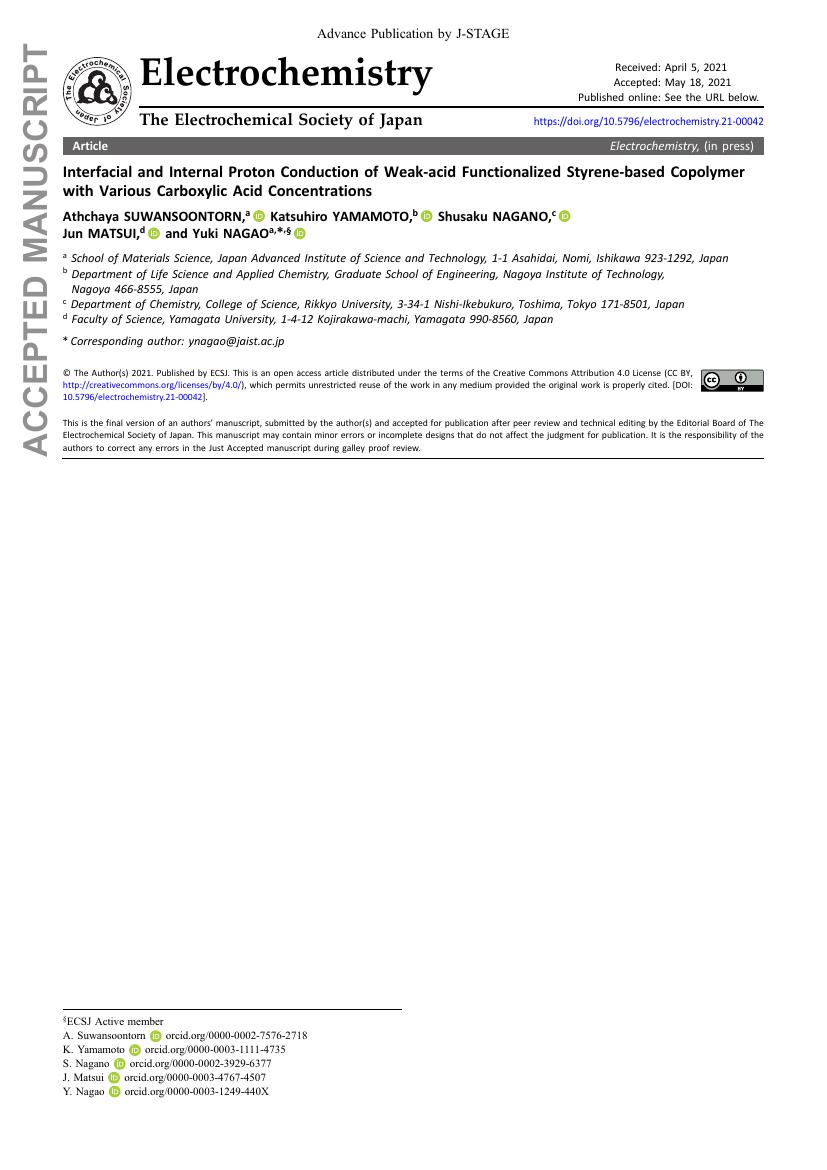- 著者
- Karthik KRISHNAN Tomoaki YAMADA Hiroko IWATSUKI Mitsuo HARA Shusaku NAGANO Kazuya OTSUBO Osami SAKATA Akihiko FUJIWARA Hiroshi KITAGAWA Yuki NAGAO
- 出版者
- 公益社団法人 電気化学会
- 雑誌
- Electrochemistry (ISSN:13443542)
- 巻号頁・発行日
- vol.82, no.10, pp.865-869, 2014-10-05 (Released:2014-10-05)
- 参考文献数
- 36
- 被引用文献数
- 1 11
The organized structure and proton transport property in sulfonated polyimide (SPI) thin film have been studied, much less is known at the interfacial charge transport during confinement of such materials. The proton conductivity of SPI thin film is correlated well with the highly oriented polymer structures as determined by infrared (IR) p-polarized multiple-angle incidence resolution spectrometry (p-MAIRS) and in situ RH dependent synchrotron grazing incidence X-ray diffraction (GI-XRD). The high proton conductivity of 2.8 × 10−1 S cm−1 at 80°C and 90% RH was achieved in the highly oriented SPI thin film. In contrast, the bulk SPI showed the drop of conductivity value at high relative humidity region, which is due to the significant structural disorder accompanied by the strong interaction between the sulfonic acid side chains and water molecules.
- 著者
- Athchaya SUWANSOONTORN Katsuhiro YAMAMOTO Shusaku NAGANO Jun MATSUI Yuki NAGAO
- 出版者
- The Electrochemical Society of Japan
- 雑誌
- Electrochemistry (ISSN:13443542)
- 巻号頁・発行日
- pp.21-00042, (Released:2021-05-21)
- 参考文献数
- 47
- 被引用文献数
- 2
Investigation of interfacial proton transport is necessary to elucidate biological systems. As commonly found in biomaterials, the carboxylic acid group was proven to act as a proton-conducting group. This study investigated the influence of carboxylic acid concentration on both interfacial and internal proton transport. Several styrene-based polymers containing the carboxylic acid group were synthesized. The amount of carboxylic acid group in the polymer chain was varied to explore the effects of weak acid concentration on polymer thin films’ electrical properties. The IR p-polarized multiple-angle incidence resolution spectrometry (pMAIR) spectra show the higher ratio of the free carboxylic acid groups rather than cyclic dimers in polymers with a higher concentration of carboxylic acid group, facilitating the more hydrogen bonding networks in films. The water uptake results reveal the similar number of adsorbed water molecules per carboxylic acid group in all thin films. Remarkably, polymer thin films with high carboxylic acid concentration provide internal proton conduction because of the relative increase in the amount of the free carboxylic acid group. In contrast, interfacial proton conduction was found in low carboxylic acid concentration polymers because of the relatively large amount of cyclic dimer carboxylic acid group and poor amount of free carboxylic acid group. This study provides insight into interfacial proton transport behavior according to the weak acid concentration, which might explain proton transport in biological systems.
